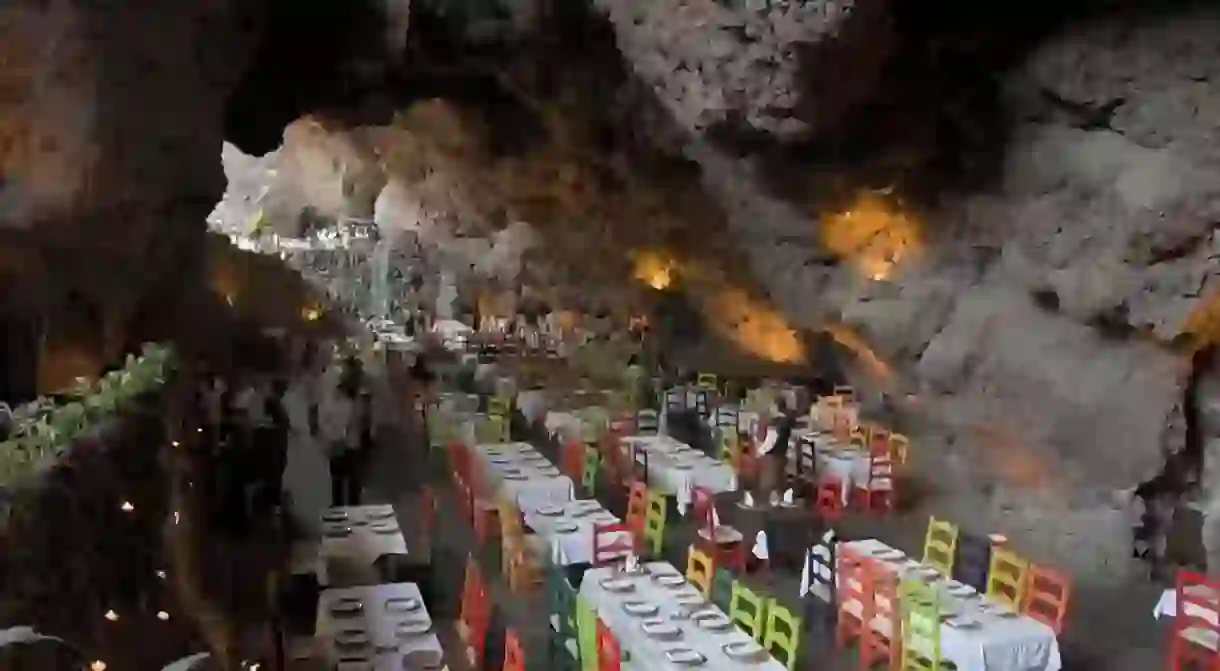Mexico’s La Gruta Cave Restaurant Is an Unmissable Dining Experience

Set just outside the boundaries of Teotihuacán, La Gruta’s epic setting in a limestone cave is a big part of its appeal.
Mexico’s mind-boggling Teotihuacán reaches up to the heavens. Its pyramids are dedicated to the sun and the moon and stand tall in the plains near Mexico City. To climb them is to feel the power and ambition of this ancient city’s mysterious architects.
But, for the ruins’ most distinctive eating experience, you need to look down. La Gruta is a restaurant in a huge cavern, its bright furnishings and cocktails contrasting with blackened walls. La Gruta has been open for over a century and offers dishes you won’t forget.

Grazing at La Gruta
The food isn’t as cheap as the stalls nearby, but it’s tasty and unusual, taking its influences from pre-Columbian dishes. On offer are classics like tortillas, barbacoa (slow-cooked) beef, guacamole, grilled corn and salad, plus an assortment of moles – the mostly savory (and very Mexican) sauces based on everything from chili to pumpkin seeds and chocolate.
Worms, ants and cricket margaritas
But that focus on traditional food also means dishes that make some diners squirm, such as escamoles (ant larvae) with green chili. Meocuiles and chinicuiles (white and red caterpillars) are served both on their own and with sliced peppers and onions. Flank steak comes with roasted cactus as well as tomatoes, onions and carrots. Cocktails are offered in a bewildering array of colours and often come with a twist, too: the cricket margarita features an insect poking out of the side of a vast, powdered goblet.
Ceremony is definitely part of the La Gruta experience – legend has it that visitors are born again when they leave the cave, and some diners light candles as a symbol of rebirth.
Visiting Teotihuacán
That reliance on rituals is fitting, because Teotihuacán is a site that’s rich in myth. Located around 90 minutes from the country’s exhilarating capital, Mexico City, this ancient metropolis predates not just the European colonists, but also the Aztecs – who found its ruins and promptly declared it ‘the birthplace of the gods’.
It was built – probably by the Totonacs, though its inhabitants were multi-ethnic – between 150 BC and AD 250, and was home to up to 200,000 people, making it the largest city in the western hemisphere before it was abandoned in the sixth century. It’s a wonderful place to visit: you can climb its vast pyramids, get some context in the impressive on-site museum and gaze at great walls and strange statues as you walk its monumental streets. Here’s everything you need to know about arranging a visit.
Recent discoveries
What makes this ‘Mexican Machu Picchu‘ even more appealing is that its mysteries are still being revealed. In 2003, a hole was discovered that led to a tunnel containing greenstone crocodile teeth, eye-shaped crystals and jaguar sculptures. Further exploration of the tunnel in the 2010s found a section in which the earth and rock had been shaped into a miniature landscape, complete with mountains and lakes filled with liquid mercury. The walls and ceiling were decorated with pyrite (‘fools’ gold’) and would have sparkled in the torchlight.
Archaeologists hope to find the tombs of the city’s rulers, and discoveries are still coming: a dig in 2019 found the remains of a great feast, including pots with Mayan markings, confirming that the city traded with – and may even have governed – what was then a relatively young Mayan empire.
The food of Teotihuacán
While tortillas are on offer in La Gruta, there’s no evidence to show that the city’s original inhabitants ate them. They had a varied diet, taking in deer, turkey, shark, turtles and frogs, as well as corn porridge and stews made from beans and cassava. A wide range of fruits were eaten, and alcoholic drinks were produced from agave plants. So when you slurp a cocktail in La Gruta’s rugged interior, you’re experiencing a flavor that has passed down through the centuries.













